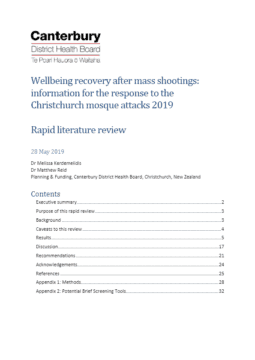Executive summary
On Friday 15 March 2019, two mosques in Christchurch, New Zealand, were attacked by one shooter. To date, 51 people have died from their injuries. Forty-five people were hospitalised on the day of the shooting, and 118 people were treated or admitted by Canterbury DHB in relation to the incident (as at 7 May 2019). Emergency personnel from the Police and St John Ambulance attended the scene. A number of members of the public assisted in the first aid response and in transporting the injured to hospital. Almost all of the injured were taken to Christchurch Hospital.
A rapid literature review undertaken suggests that mass shootings are more intensely traumatic than other disasters, but that the majority of those affected by mass shootings will be resilient. Most people will be minimally impacted, but approximately eight percent may have moderate symptoms and two percent chronic dysfunction (Despotes et al. 2016). These prevalence figures depend on the context of the event.
An overview of the literature suggests the intensity of symptom trajectories are likely to vary over time and among groups, and depend on pre-existing risk factors (including young age, female gender, low socioeconomic status), high incident exposure (close proximity to the event or psychosocial proximity to deceased, concern they would die during attack), and differing coping strategies.
Locally those most at risk would be people highly exposed to the event, those from the targeted Muslim community, emergency responders, young, female, and potentially those with a loss of income, and concerns about residency status/ability to stay in New Zealand.
An appropriate response could be multi agency, similar to that offered in the aftermath of the Manchester Arena bombing. This should be directed in the first weeks at normalising anticipated reactions and supporting coping mechanisms and natural networks, through multiple routes including public health messaging, social marketing, the patient information website HealthInfo, primary care, and workplaces. After the initial weeks, the emphasis should shift to identifying those that need a higher level of assistance, focusing on those who have experienced greater levels of trauma, and those with previous mental health difficulties, as they may be more vulnerable. Training on ‘Mental Health First Aid’ may be beneficial in this context. Strategies are suggested in this document. In the longer term, the triggering nature of anniversaries of the attacks should be considered.
Evaluation of any initiatives should be incorporated into the response.

